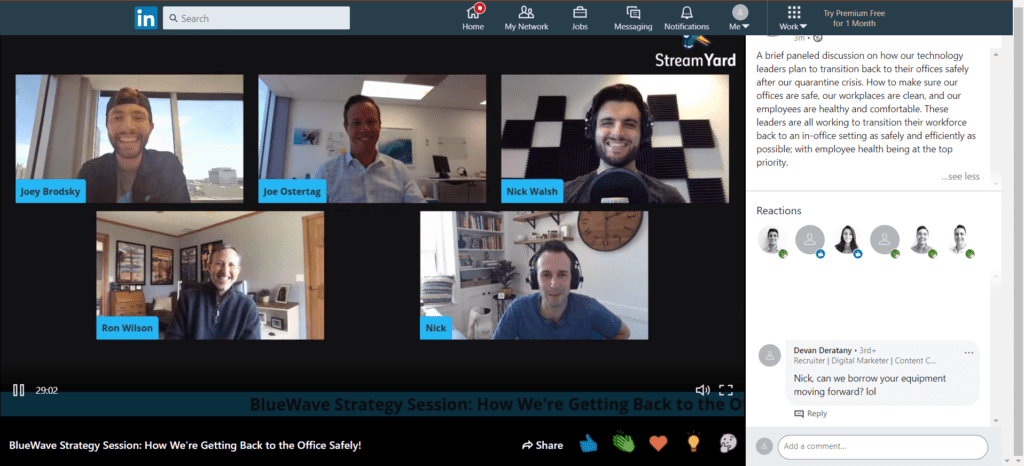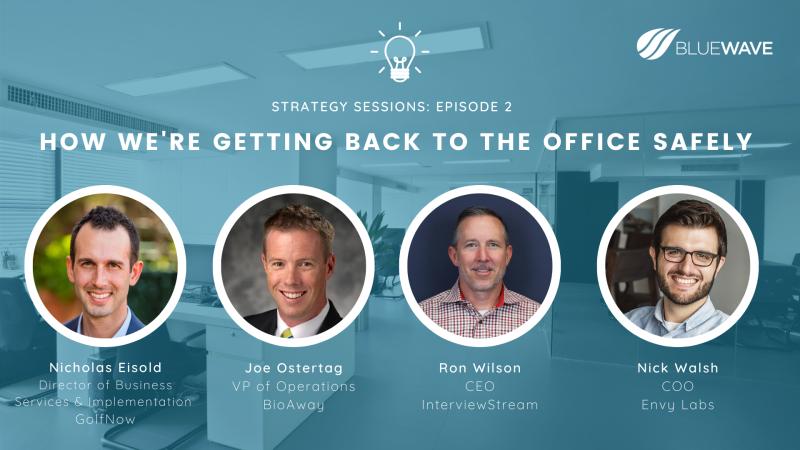Managers and employees alike have become accustomed to the office life. Driving to work. Hanging out in the kitchen and catching up before clocking in. Facing off with ping pong matches in the afternoon.
The pandemic has significantly changed these office moments and company cultures. In this LinkedIn Live Strategy Session, Joey chatted with Nicholas Eisold, Joe Ostertag, Ron Wilson, and Nick Walsh about what they’re doing to keep a positive company culture, if their teams are going back to the office, and how they’re doing so safely.

Bring employees back one step at a time
Nicholas Eisold, Director of Business Services & Implementation at GolfNow, says they’re only bringing back essential staff at the moment. For GolfNow, essential staff includes producers who need to work on matches, such as the staff who needed to produce the Rory McIlroy and Rickie Fowler match back in May.
Nicholas says office workers and non-production staff will be the last to return to the office, working from home in the meantime.
“The reason I want to go back into the office is for the human interaction with my teammates,” Nicholas said. “I want to give them a high five. I wanna give them a fist bump, but I can’t. If I’m gonna have to stay six feet away anyway, why don’t I just do this [work from home]?”
Joe Ostertag, VP of Operations at BioAway, works both at home and in the office. BioAway’s disinfectant services are essential, so they’re always working to help keep offices safe and clean.
“There was a big shift of a lot of people working from home, a lot of people that aren’t in the tech sector, a lot of difficulty there,” Joe shared. “As we’re talking to our clientele and we’re hearing about their plans, we’re hearing there’s a lot of different plans out there. I think there’s gonna be a phase coming back in here where we have to hold each other’s hand and clearly define expectations and what the new norm is.”
Adapting to new communication methods
When we’re in the office, we’re bound to come across the corporate nod or smile to acknowledge someone (you know, when we’re walking down a long hallway and see someone at the end of that walk).
“With a mask on, the smile…you can’t see it. So now I look like a jerk,” Nicholas joked. “I have to readjust that because I can’t even do my smile anymore.”
Staying in communication with your team is a healthy way to check in using online tools. Whether that’s through email, Slack messages, video calls, or some other method, find what works best for your company based on your team.
“9 weeks of not seeing another person other than in the grocery store is mentally taxing,” Nicholas said. “From leadership, we overcommunicate and try to provide outlets for [employees], especially for people who might not feel comfortable reaching out on their own to say, ‘I’m having a hard time.’ Providing those spots for people has been super important for us.”


Showing empathy with new work-from-home environments
Managers understand that not everyone has an ideal home environment where they are.
“Come as you are. Don’t stress about what’s happening over here. Just be here, we get it. Bring your dog in, bring your kid in. Be present when you can,” Nicholas said.
It’s also important to note that some employees are working in different time zones, so their reply time might be off.
“Making sure that people understand that because we’re all distributed, no one really has the same 4 hours anymore, especially if they have kids,” Nick Walsh, COO at Envy Labs, said. “You can send a message, but you shouldn’t expect to get one back. But make sure it’s in a public location so they can give you an answer at some point. Following that has been a big help.”
Making sure company culture remains in a positive place
Ron Wilson, CEO of InterviewStream, was prepared with a third of his team already being remote, and the other two thirds working at an office in downtown Chicago.
“We already had a culture of remote employees and engaging with remote employees. It was very easy for us to pivot to 100% remote,” he said. “That may be permanent as many organizations realize that you can be effective and perhaps even more productive working remote.”
Ron’s being flexible so employees who feel comfortable can return to the office, and those who don’t feel comfortable can work from home.
“We’re gonna keep creating the environment to enable them to work at home as much as possible,” he said.
Using video for internal team meets and for the hiring process
Ron shares that his team has daily stand-up meetings, weekly all-hands company meetings, and keeps everyone informed of what’s going on through video meetings.
“We’ve been leveraging video as a technology for all of our interactions, whether it’s one-to-one, one to many, or company-based interactions,” Ron said. “We’re actively continuing to hire. We eat our own dog food; we’re using our platform to continue to facilitate the hiring and interviewing processes.”
Nick says his team’s go-to communication tools are Google Drive, Hangouts, Slack, and Basecamp. He also frequently checks in with other digital agency owners through Slack to help this feel more normal.
“It’s been wonderful to commiserate with hundreds of others that are going through the same thing and trying to figure out paycheck protection, and all of it,” he said. “Everyone’s confused and trying to figure it out.”
Keeping employee wellness top of mind
Since more companies have pivoted to remote work, there’s been a noticeable decrease in employees scheduling vacation time. This comes down to the unknowns of traveling, plus the comfort of turning on the computer from home and working at all hours of the day and night.
“People are now looking forward to Mondays because there’s no carrot to work towards,” Joe said. Ski trips and weekend getaways are less common.”
Employees are being productive at home, but they will experience burnout at some point by not taking time off. Nick says he wants to make sure his team knows it’s OK and it’s necessary to take PTO to step away from everything and reset.
He says it’s important for managers to be flexible since there’s not going to be one definition of “normal” for anyone. The important thing is to listen to your team and adjust your strategy from there.


Getting creative with teambuilding activities
Companies have recently shifted from in-person happy hours at the bar down the street to clinking glasses on the screen.
InterviewStream began hosting virtual happy hours during quarantine, using Zoom breakout rooms to place employees in different discussion groups based on their interests, such as woodworking, musicians, and foodies.
At BlueWave, our team meets weekly for themed happy hours on Zoom (sometimes we cry from laughing so hard). We’ve also had a “Goat 2 Meeting” as a team reward, getting a virtual tour of a farm (goats included).
Something as simple as a branded company face mask has even helped make the transition to working from home -or returning to the office safely – a little easier.
“That’s gonna be a staple of company’s swag – the custom branded face masks. It makes this weird thing a little easier and a little more fun for everyone when we’re trying to get used to it,” Joey said. “It’s nice that at least we’re all living this reality together.“
Staying safe as a team
Returning to the office will require mental and physical effort. Employees will need to get back in the swing of commuting. Ron mentions employees should also be aware of their personal hygiene and their wellness, sanitizing work areas and being social in a way that’s comfortable for everyone involved.
“We’re gonna continue to try to keep it fun,” Ron said. “But I’m mindful that there’s definitely core people who want to get together and want to engage. There’s gonna be people all over the spectrum in regard to their comfort. We gotta be careful to avoid peer pressure, to engage in our work and social activities. I think we gotta be mindful of that.”
Joe notes that everyone in the company will need to work together to follow certain boundaries and sanitizing protocols in the office.
“It’s really going to be a team approach,” he said. “[BioAway] can give you the starting point, and then continue with our services…but it’s really going to be creating an SOP for your employees, having procedures in place, and some self-policing.”


Ready to grow your team, wherever they are?
Whether your team is working remotely or slowly returning to the office, we’re here to support your company growth. Get in touch with us to find candidates who fit both your skill requirements and your company culture.



